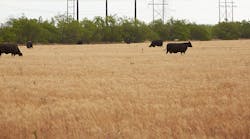Rights-of-way frequently pass through or are adjacent to pastures grazed by livestock. For vegetation managers and herbicide applicators, this is significant because it’s illegal to apply herbicides — in this case, herbicides without grazing tolerances to land used for grazing (even if it’s land converted to pasture after the fact) — on sites not labeled for use under the Federal Insecticide, Fungicide, and Rodenticide Act.
It’s comparable to spraying a nonaquatic-use herbicide directly into water. Additionally, it can lead to unfortunate situations such as a herd of valuable beef cattle grazing forage that has been treated improperly, and, in turn, not being able to be sold for human consumption by the rancher. And there’s little doubt as to where that rancher will look to for reparations.
Grazing tolerances are established for a pesticide by the U.S. Environmental Protection Agency. They are only established for products that have undergone stringent testing for use of the pesticide on grass, hay or other feedstock for livestock animals such as cattle, horses, sheep and goats.
Only herbicides with grazing tolerances should be used to treat unwanted vegetation in grazed areas. Products with grazing tolerances may have certain grazing restrictions, which are listed on the product label. The restrictions include any special instructions (such as maximum allowable use rates, and how to handle hay, manure or use for lactating dairy animals) pertaining to applying the herbicide within grazed areas.
Three easy tips to avoid issues
Tip 1: Eliminate risk altogether and prescribe or use only herbicides that contain grazing tolerances. For example, all Vegetation Management herbicide products from Corteva Agriscience™, Agriculture Division of DowDuPont, including Milestone®, Vastlan® and Opensight® herbicides, have grazing data packages with no or limited restrictions on use.
Tip 2: Even when using herbicides with grazing tolerances, it’s still a good policy to practice proactive landowner communication prior to application, especially in areas where grazing is likely. It helps alleviate landowner concerns, and it can help spur discussion regarding sensitive areas not on your radar.
Tip 3: It’s also a best practice that when planning for a herbicide bid package, vegetation managers should work with applicators to fully assess grazing lands or other sensitive sites that applicators might encounter. It minimizes confusion and reduces the chance for error. For an extra layer of protection, specify in the bid package that only products with grazing labels be used.
It’s easy to overlook this issue by assuming everyone understands what is or isn’t pasture, or that applicators in the field will just switch tanks when they do encounter it. At some point, it will likely lead to unintended consequences, such as angry phone calls from landowners — or much worse.
Sponsored by:
™®Trademarks of Dow AgroSciences, DuPont or Pioneer, and their affiliated companies or their respective owners. When treating areas in and around roadside or utility rights-of-way that are or will be grazed, hayed or planted to forage, important label precautions apply regarding harvesting hay from treated sites, using manure from animals grazing on treated areas or rotating the treated area to sensitive crops. See the product label for details. State restrictions on the sale and use of, Milestone and Opensight apply. Vastlan is not registered for sale or use in all states. Contact your state pesticide regulatory agency to determine if a product is registered for sale or use in your state. Always read and follow label directions.



